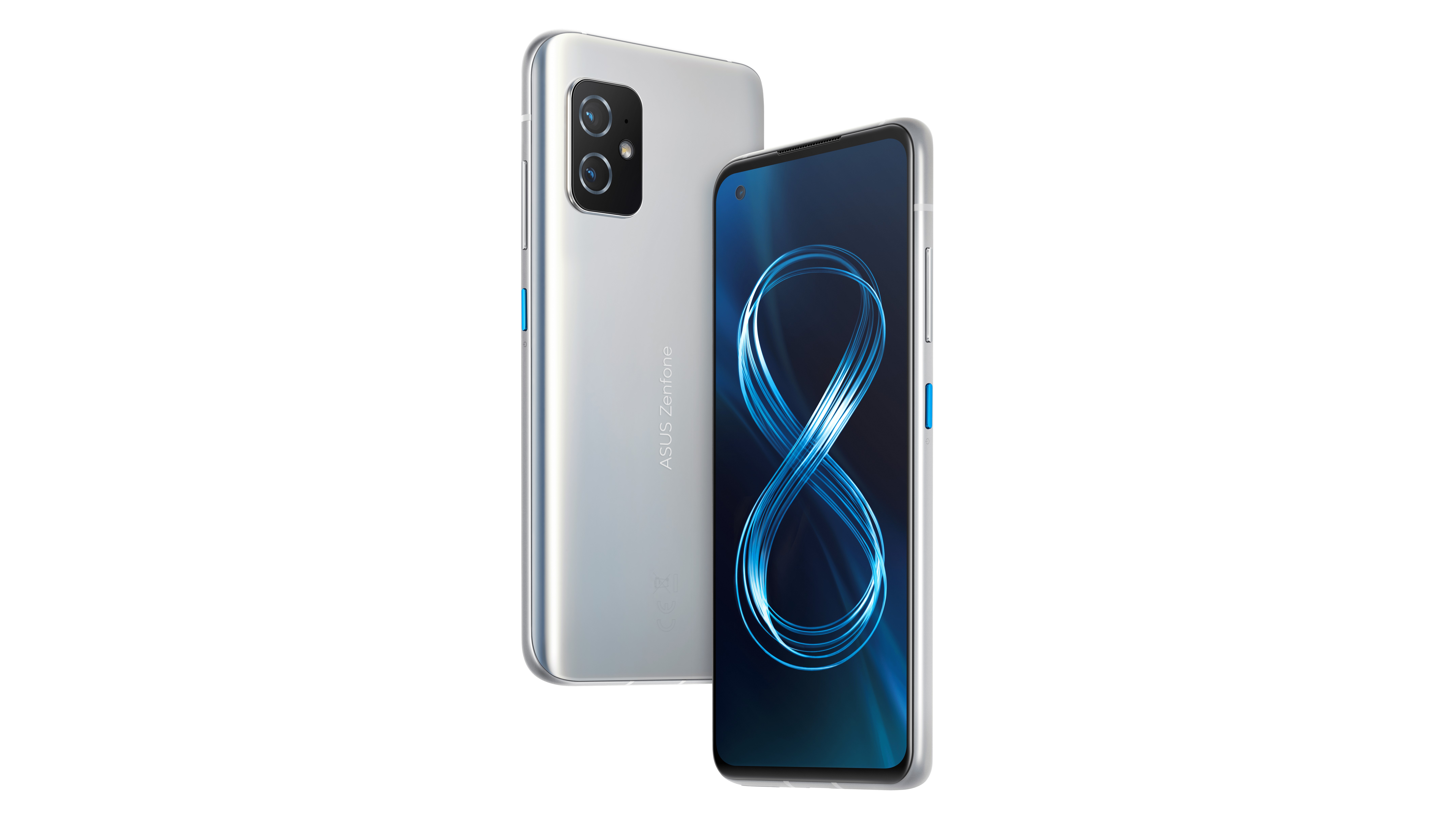Asus Zenfone 8 review: compact and powerful
The Asus Zenfone 8 proves that bigger doesn't always mean better when it comes to performance


The Asus Zenfone 8 is truly compact and somehow still manages to pack in impressive hardware. It may not look like anything special straight out of the box, but it really does have a stunning display and flagship-level performance.
-
+
Fast performance
-
+
FHD+ resolution, 120Hz refresh rate
-
+
Compact and lightweight
-
-
Plain, simple design
-
-
Camera lacks oomph
-
-
No MicroSD card slot
Why you can trust T3

Asus Zenfone 8 review - key specs

Dimensions: 148x 68.5x 8.9mm
Weight: 169 g
Screen: 5.9 inches AMOLED (120Hz, HDR10+)
CPU: Qualcomm Snapdragon 888
GPU: Adreno 660
RAM: 16GB
Storage: 256GB
Rear cameras: 64MP, 12MP
Front cameras: 12MP
Battery: 4,000 mAh
OS: ZenUI 8 Android 11
5G: Yes
In short, what you should take away from this Asus Zenfone 8 review is that great things can come in small packages.
Over the years, phones have been getting bigger and bigger, packing in more and more impressive tech. T3's guide to the best Android phones is packed full of devices with 6.5inch screens and above. For some, a large phone with a large screen is perfect. For others, it’s uncomfortable and unnecessary, especially if you have smaller hands.
As things stand there isn’t much out there for those who want top-tier specs in a smaller handset. Asus aim to fill the gap with the Zenfone 8 creating what they’ve labelled as “the ultimate compact Android phone”.
At first glance, this small phone with its 5.9inch display doesn’t look like anything special but delve a bit deeper and you’ll find out that it's actually a lot more interesting than it first appears. Asus has managed to fit in a top of the line 5G processor, plenty of RAM and high-end screen tech. So how does it match up to those ginormous flagship smartphones? Read on to find out.
Asus Zenfone 8 review: price and features
Launched on the 12th May 2021, the Asus Zenfone 8 will be available soon directly from the Asus website with 8GB RAM and 128GB storage for £599 (roughly AU$900). Or with 16GB RAM and 256GB storage for £699 (roughly AU$1,200). In this review, I checked out the 16GB / 256GB version. US pricing should be around $599 for the base model and $799 for the top-spec version.
What sets this phone apart from the crowd? The Asus Zenfone 8 has a comfortable 5.9inch FHD 120Hz display and a compact design. Other features include the top-of-the-line Qualcomm Snapdragon 888 processor, a 4,000mAh battery, a 64MP main camera and a durable build.
Asus Zenfone 8 review: design and display

Available in Obsidian Black and Horizon Silver, from the outside the Asus Zenfone 8 keeps things simple and doesn’t have much of a wow-factor in design features or colours. It measures 148 x 68.5 x 8.9mm and weighs only 169g - for comparison that’s over 20g lighter than the OnePlus 9 and the Samsung Galaxy S20 FE.
Get all the latest news, reviews, deals and buying guides on gorgeous tech, home and active products from the T3 experts
The 5.9inch display is surrounded by slim bezels, its screen-to-body ratio is 90.2% so they’re not as thin as you get on other phones. It’s only interrupted by a hole-punch camera in the top left of the screen, it's framed with a silver ring which looks a little out of place. The small screen made the phone comfortable to use with one hand, despite the phone itself feeling quite thick. On the back, it has a small two-lens camera module, while on the frame you'll find a USB-C charging port and 3.5mm headphone jack. There’s no SD card slot to expand the storage on the Asus Zenfone 8. In the box, you get a 30W charger, USB-C cable and a protective case for the phone.

Using the Samsung E4 AMOLED display with a resolution of 2400 x 1080p (FHD+) and 1,100nits peak brightness, it easily matches up to high-end flagship phones in almost every area except size. It doesn’t feel as crisp as the most expensive handsets but the 120Hz refresh rate gives it just as smooth a scrolling, swiping and gaming experience. The HDR10+ support means you can make the most of TV streaming sites like Netflix, it provides more detailed colours and a better contrast to enhance the video quality overall. The Asus Zenfone 8’s display also has always-on capabilities. Impressive!
To unlock the phone, the Asus Zenfone 8 features an in-display fingerprint reader. Sometimes these can be temperamental, this one was reliable and registered my fingerprint quickly every time.
Asus Zenfone 8 review: camera

The Asus Zenfone 8 only has two camera lenses on the back- a 64MP wide camera and a 12MP ultrawide camera. It comes as a surprise considering the recent trend for at least three rear lenses, which also means there's no dedicated telephoto lens. On the front is a 12MP selfie camera.
Point-and-shoot photos were of decent quality yet they did come out looking a little on the bland side in comparison to high-end flagships. The colours lacked vibrancy and definition, while it didn’t do a great job at brightening up darker areas of the shot either. In saying that the camera still managed to pick up tonnes of intricate detail in the image, something that is most apparent in shots up close to the subject. Take a look at the gallery below to see some of the shots I took on the Asus Zenfone 8.







Video can be recorded in resolutions up to 8K at 24fps. There are also a few different video modes to try out like Time Lapse and Slow-Mo. Just like with still images, videos on the default FHD settings came out looking a little on the dark side. They didn’t suffer from too much shakiness or grain though.
Asus Zenfone 8 review: performance and battery

Packing the Qualcomm Snapdragon 888 processor and the Adreno 660 GPU with 16GB RAM and 256GB storage, the Asus Zenfone 8 is just as powerful as any recent flagship. A massive achievement considering its tiny size.
It happily coped with photo edits and mobile games, as proved by its Geekbench 5 scores where it matched up to the Samsung Galaxy S21 Ultra and the Xiaomi Mi 11 Ultra with a single-core score of 1,124 and a multi-core score of 3,752. Those are some of the best scores we’ve seen, especially on a phone of size and stature.
Supporting 5G, you’ll be guaranteed the fastest speeds on your network if you live in an area that supports it. Similarly, if you have the right kit, the Asus Zenfone 8 has Wifi 6 so you’ll be able to make the absolute most out of your home broadband as well.
The 4,000mAh battery is smaller than on pricier flagships. Over two hours of video on full brightness, the phone’s battery dropped by 16% suggesting that it would have lasted 12.5 hours all in all, which isn't bad, but it's not amazing either. There are five battery modes to choose from, so you’ll only be using up what you need to, if you remember to switch between them that is. They include a high-performance mode, the standard dynamic mode, a durable mode that regulates performance and connectivity to preserve battery, an ultra-durable mode that sets performance level for essential system operations only and the advanced mode giving you personalised battery settings.
When it does run out of battery, the phone will only take just over an hour to recharge. Even if you only charge it for half an hour, you'll get enough juice to last most of the day. What’s more, is the scheduled charging feature which prevents wear on the battery by keeping it at a lower percentage while plugged in overnight so it doesn't trickle charge at 100%. That should mean your battery stays consistent for longer. One downside of the Asus Zenfone 8 is that there's no wireless charging.
Running on ZenUI 8, the operating system feels close to pure Android, just perhaps a slightly less sophisticated version of it. It’s intuitive, well-organised and easy to use. The phone comes with the essential Google apps installed and the basic smartphone apps you’d expect like a calculator and contact address book. Asus doesn’t bore you with unnecessary apps in its user interface. When you swipe down from the top, you’ll also find a one-handed mode, not that you really need it with the screen being this small.
Asus Zenfone 8 review: verdict

Asus aren’t necessarily the manufacturer you’d look towards in your hunt for the best smartphone, which is perhaps why they’ve made such an effort to fill a significant gap in the market.
A compact phone with plenty of power, the Asus Zenfone 8 may not be the best-looking smartphone there is, but it is one of the fastest. You can’t expect to take award-winning photos using the basic camera system and you don’t get days and days of battery from it either. What you do get is an upper-mid-range phone with high-end performance that will easily fit into your pocket. It's all about simplicity, speed and proving that bigger doesn't always mean better!
Asus Zenfone 8 review: also consider
If it’s a compact phone you’re after, then you still can’t beat the Google Pixel 4a - it’s got a 5.81inch display and costs less than $350 / £350. You won’t get a super-powerful phone fit for any type of task, however, you will get a fantastic all-rounder with a decent camera. It is arguably the most popular small phone you can buy.
Another phone worth considering is the Sony Xperia 5 II which is an impressive phone in pretty much every area, and it is similar in price to the Asus Zenfone 8. This handset really excels at photography and in the quality of its 6.1inch screen which is perfect for streaming video.
- Want a pure Android experience? Check out the best Samsung phones

Yasmine is the former Reviews Writer for T3, so she's been knee-deep in the latest tech products for reviewing and curating into the best buying guides since she started in 2019. She keeps a finger on the pulse when it comes to the most exciting and innovative tech – and since departing has also held a role as Digital Spy's Tech Editor. In her free time, you'll catch her travelling the globe – the perks of being a freelance tech expert – tending to her plants when at home and, but of course, planning her next big trip.